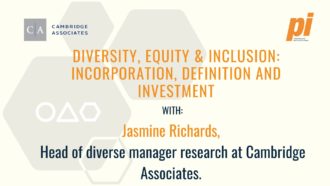Within the ESG debate there is an on-going discussion about whether investors should take a divestment stance or focus on engagement. This dilemma was a hot topic at portfolio institutional’s inaugural Diversity Webinar in November. “Divestment is something we see a lot of in the ESG sector and on climate change – should you divest, just divest from fossil fuels or engage with companies?” said Laasya Shekaran, an investment consultant at Lane Clark & Peacock, when identifying the parallel between ESG and diversity narratives.
“Most of the research points to engagement being the first step, because then you have the ability to change things, to help turn the big emitters around. Whereas, if you just divested from them, nothing would change,” she added.
But Shekaran noted that there needs to be a divestment threat when it comes to diversity issues. “Engagement is an important first step, but the threat of divestment needs to be real for them to do something about it. They need to see that if they carry on with their practices the way they are, we will not continue to invest with them. It is a business risk – and that leads to financial risk.”
Geri McMahon, a partner and co-head of responsible investment at Aon, agreed with engaging as a first step and that a potential divestment could be a useful tactic. “Investors are in a real position of influence to make a significant contribution towards driving change. Engagement cannot be indefinite,” she added. “There needs to be monitoring and a consequence for a lack of progress.”
Early days
But Helen Price, head of stewardship at Brunel Pension Partnership, calls for a different approach. “It is still early days in our discussions around diversity,” she said, “and we do not have the data needed to make a proper assessment of where we are at. So, it is far too early to start talking about divestment in this area.
“There are actions we can take to seek improvement,” she added. “We have seen a ramping up of engagement. Over the past year we have seen a lot of shareholder resolutions led requesting diversity information to be disclosed. We have also seen requests on remuneration and the objectives of senior management. So, it will evolve over time.”
Adding another more subjective dimension, Shekaran said: “On a personal level, if I knew my pension was invested in a company that had a history of sexual harassment, racism or transphobia, I would not want my money to be invested there.”
But she added that a sense of realism was also needed. “If we decided to divest from every company that didn’t have the best equality practices or a diverse representation, there wouldn’t be anything left to invest in.
“So, engagement is a first important step, but divestment should be a real tool to consider,” Shekaran said.
Join the club
Diversity has a new and stronger investor voice with the creation of the Asset Owner Diversity Working Group and the Asset Owner Diversity Charter, where 19 signatories representing £1.8trn are committed to considering diversity and inclusion when appointing fund managers.
Price was a key architect of this game-changing initiative. “It was great to see the support this initiative has received, including from consultants,” she said. “Since its launch we have had a lot of interest in the industry taking on two additional signatories and we have also been working with different platform providers.
“We want to reach more asset owners across the globe – in the US and Europe. We want to keep developing it over time, to keep the conversation going.”
I asked her how fund managers have responded, as it potentially puts them in the ring line. “Overall, the reaction has been great,” Price said. “The proof of the pudding will be the responses we get to the questionnaire, which will be rolled out in 2022.”
So, the Asset Owner Diversity Charter is a good point to be at, but what are the next steps for institutional investors to address diversity? “Education is an important first point: understanding why diversity is important, the financial aspects of it, but also how it aligns with their values,” Shekaran said.
“The charter is a good way of getting started because it outlines how you can start incorporating diversity and inclusion into your practices in a meaningful way,” she added.
But Price does not want it to stop here. “I would love to see it embedded in the tender process,” she added, “and is part of the investment decisions managers make.”
For Sarah Maynard, global head of external inclusion and diversity at the CFA Institute, there is an impetus on company leaders and investors to take a stand and embed diversity into their strategic objectives – similarly to how ESG has developed. “There are many small steps, but leadership and governance matters,” Maynard said. “So, it needs to be embedded in the business strategy.
“There also needs to be measurement. Measurement that gives real transparency, which is important.”
Boardroom diversity
When it comes to boardrooms, a big question is, why are they not more diverse? Arun Kelshiker, advisory board member at Cambridge Sustainable Investment Partners, had plenty to say on the topic.
“There has been a lot of research that shows there is an increase in company performance – both enhanced performance and other risk metrics, governance and the like – which are supported by a more diverse environment,” he said.
He cited McKinsey’s diversity report, which highlights companies in the top quartile for gender diversity in their executive teams as being 21% more likely to report above average profitability than companies in the fourth quartile. The report also highlights that companies in the top quartile for ethnic and cultural diversity are a third more likely to report a profit outperformance than bottom quartile companies.
Analysis by Bank of America revealed that S&P500 companies with above median diversity on their boards saw a 15% higher return on equity than companies that did not have those traits. And for a racially diverse workforce, it was 8% higher. “Clearly the numbers are supportive of enhanced company performance linked to a more diverse and inclusive representation on the board and within senior leadership,” Kelshiker said.
There have been movements to push the diversity debate forward. Initiatives like the Hampton-Alexander Review wants at least a third of FTSE350 directors to be female, while the Parker Review targets at least one ethnic director on each FTSE board.
“That has come under pressure,” Kelshiker said. “Across FTSE250 companies, 59% did not meet that target.”
There is no destination to this journey. It is all about progress.
Rina Goldenberg Lynch
Diversity by numbers
But McMahon offers a word of warning on this issue. “When it comes to data, don’t let perfect be the enemy of good,” she said. Rina Goldenberg Lynch, founder and chief executive of inclusion-focused consultancy Voice at the Table, has a similar view. “Looking at diversity in numbers is not helpful. We should look at the business culture first.”
She added that antipathy is why it is di cult to change the way we do things, especially at board level. “So, the first barrier is making that change within and identifying your own obstacles to it and working on those day in, day out. The changes we have seen so far cannot be discounted. It is a long journey.”
Kelshiker used the event to explore an interpretation of diversity. “Diversity is all about cognitive diversity: experiences, views, perspectives, identity and having that diverse thought as a conversation within the boardroom,” he said. “Group think can be an issue with boardroom decision making and having diversity in the room makes for a far richer conversation, far better governance and risk management.”
Goldenberg Lynch noted the validity of the point. “On a board, diversity may not be great, but there is still a lot of diversity there. For me it is about tapping into the diversity of each of the individuals who are already there,” she said.
But Goldenberg Lynch also noted again how boardrooms can find it difficult to change, even if they pretend that they are. “There is a desire at a senior level to create diversity. It can look different, but it has to feel the way it has done before and that is where the problem lies,” she said.
Those who came before
Beyond the boardroom there is a need for senior role models, McMahon said. “I spent eight years on a trading oor with no role models, never worked directly with another female trader and there was no woman senior to me,” she added.
“What is important to me now is the young people in my team have that experience. I want them to look up and see role mod- els, see themselves represented and feel included and so they can believe they can progress to the highest level within our organisation. Achieving that is a measure of success.”
The issue of what type of diversity representation exists throughout an organisation is vital, Price said. “You could have an organisation that has great representation at board level, but when you go lower you may nd all the women are in the back o ce or not in decision-making roles,” she added. “So, without getting under the bonnet and looking at diversity throughout the whole organisation you could make unintentionally bad decisions.”
Adding another take on diversity, McMahon added: “We hear and talk about gender and race, but not much about disability,” she said. “Until the position arose of me employing someone who was visually impaired, I had never thought about accessibility myself.”
A picture of success
When or how will we know if success has been achieved on the diversity front? “There is no destination to this journey,” Goldenberg Lynch said. “It is all about progress. The journey is about becoming more and more aware of situations and trying to improve,” Goldenberg Lynch said, with Kelshiker adding: “It is about having not just a diverse workplace but an inclusive one.”
For Price, success will come when “numbers speak volumes”. She believes it will come when the industry works in harmony and when more asset owners are embedding diversity into their practices and managers provide greater disclosure. Shekaran concluded that it was important to understand the gravity of the challenge. “We are trying to undo centuries of inequality.
“I don’t know what the ultimate utopia is because it is so far from the real world now, but we don’t have to get to that point to have serious inclusion.”





Comments